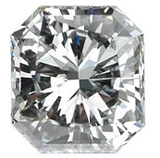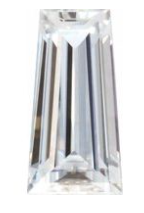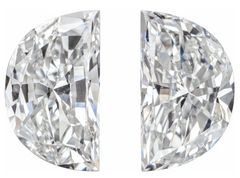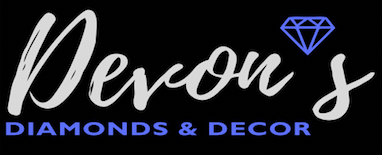
Which Diamond Shape Suits You?
DIAMONDS

DIAMOND SHAPES
ROUND BRILLIANT CUT DIAMOND

The round brilliant diamond is the most popular diamond shape. This is because the diamond offers remarkable white light reflection, also known as brilliance, due to it's large number of carefully constructed facets. These facets make the round cut diamond brighter and more brilliant than all of the other diamond shapes. Virtually all round diamonds are brilliant-cut, meaning that they have 58 facets. They are the only diamond shape that the GIA grades for cut.
(Click here to learn more about round brilliant diamonds.)
MARQUISE CUT DIAMOND

The marquise diamond is a modified brilliant-cut, which features elongated, pointed ends that give it a curved, football shape. The marquise cut diamond’s long and narrow shape gives it an illusion of greater size than other shapes of the same carat weight. Symmetry is very important with this shape. The slightest difference can create an uneven, imbalanced look.
(Click here to learn more about marquise diamonds.)
PRINCESS CUT DIAMOND

The princess cut diamond is among the newest of the diamond cuts. It is a square-shaped diamond with sharp corners. This diamond cut often carries less premium then other diamond cuts because there is less waste in the shaping process. Typically this diamond retains about 80% of the original rough diamond which greatly reduces the cost of manufacture.
(Click here to learn more about princess cut diamonds.)
CUSHION CUT DIAMOND

The cushion diamond gets its name from looking like a pillow cushion with its square shape and smooth, rounded corners. Some may appear more rectangular, while others are closer to squares. This diamond is a combination of a more modern, round brilliant cut pattern diamond with a classic, old mine facet pattern diamond cut. Cushion cut diamonds are generally less brilliant than round brilliant diamonds although they often have better fire, which is part of their appeal.
(Click here to learn more about cushion cut diamonds.)
EMERALD CUT DIAMOND

The emerald cut diamond features a rectangular profile with beveled corners, along with a large table that provides a view of the facets beneath. This creates the illusion of a larger size. These facets are not the same style as a brilliant cut. Concentric rows of step-cut facets are on the diamond's crown and pavilion which run parallel to the girdle, creating a mirrored effect that results in dramatic flashes of light. Since emerald cut diamonds typically have far fewer facets than other popular diamond shapes, they display less brilliance.
(Click here to learn more about emerald cut diamonds.)
ASSCHER CUT DIAMOND

The asscher diamond is an octagonally shaped diamond and is similar to the emerald cut because it has that same "step cut" design. The difference between them is that the asscher cut has more facets which makes them more sparkly then the emerald cut. The asscher cut diamond has a strong association with the Art Deco era. Because of the shape of the stone and the way the facets are cut, asscher cut diamonds have retained their classic appearance.
RADIANT CUT DIAMOND

OVAL CUT DIAMOND

The oval diamond has probably the longest known history. You can think of it as a round brilliant diamond that is stretched on its sides. Containing fire and brilliance, the oval diamond is suggestive of the round shape but is more unique. The oval can be narrow or wide, depending on personal preference.
(Click here to learn more about oval diamonds.)
PEAR SHAPED DIAMOND

The pear shaped diamond is considered a "fancy shape,” meaning it’s a shape other than round. Reminiscent of a tear drop, this diamond has a gently rounded bottom and a narrow, pointed top. This diamond shape is a mixture between the marquise cut and the round brilliant which gives its unique look. Also, like the marquise cut, symmetry is an extremely important factor. A pear shaped diamond tends to hold more color than a round brilliant. Therefore, it is best to choose a diamond that is high on the GIA color scale.
(Click here to learn more about pear shaped diamonds.)
HEART SHAPED DIAMOND


ACCENT DIAMONDS
The beauty of jewelry is in the details. When buying diamond jewelry, have you ever noticed smaller diamonds added for extra sparkle? These small stones enhance the large center diamonds that you were viewing above. These smaller diamonds are called accent diamonds. While most customers focus on the main diamond – the center stone – accent diamonds often get overlooked.
WHAT ARE ACCENT DIAMONDS?
Accent diamonds (or sometimes called diamond accents) are smaller diamonds that are placed beside or around a large diamond in a jewelry piece to enhance its look, volume, sparkle, and design. They are an accent – an added piece and in a way, an elaboration to amplify the beauty of a jewelry piece. These small diamonds are available in different shapes. Accent diamonds are real diamonds. They are graded for color, cut, clarity and carat weight, just as large real diamonds. They are just smaller diamonds and hence less valuable individually.
TYPES OF DIAMOND ACCENT SHAPES
The cut and shape of diamond accents can vary, but usually, they are found in a straight baguette, tapered baguette, trapezoid, trillion, bullet, half moon and classic round cuts. These shapes best complement different types of center gemstones while maintaining a reasonable price point.
STRAIGHT BAGUETTE DIAMOND

TAPERED BAGUETTE DIAMOND

A tapered baguette diamond narrows on one of the two ends, resulting in a unique trapezoidal shape.
TRAPEZOID DIAMOND

TRILLION DIAMOND

A trillion cut diamond is a diamond that's cut into a triangular shape. A typical trillion cut diamond will have three sides of equal length, with a flat table at its surface.
BULLET DIAMOND

A bullet cut diamond is traditionally a step cut diamond used as matched pair to center stones. The name comes from the shape of a bullet.
HALF MOON

ROUND DIAMOND

A round cut diamond, as mentioned above, is the most popular diamond shape, and that goes for accent diamonds as well. This is the most commonly used shape for accent diamonds set in jewelry.
DIAMONDS NEAR ME

